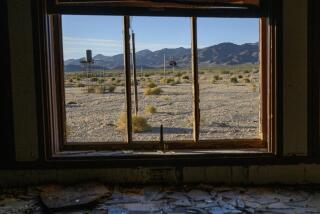Minute Shift in Temperature Has Had a Major Effect on Earth, Studies Show
Gradual warming over the last 100 years has forced a global movement of animals and plants northward, and it has sped up such perennial spring activities as flowering and egg hatching across the globe -- two signals that the Earth and its denizens are dramatically responding to a minute shift in temperature, according to two studies published today.
One study showed that animals have shifted north an average of nearly four miles per decade. Another study showed that animals are migrating, hatching eggs and bearing young an average of five days earlier than they did at the start of the 20th century, when the average global temperature was 1 degree cooler.
That 1 degree, according to the studies, has left “climatic fingerprints” -- pushing dozens of butterfly and songbird species into new territories, prompting birds and frogs to lay eggs earlier and causing tree lines to march up mountain slopes.
In some cases, the shifts have been dramatic. The common murre, an Arctic seabird, breeds 24 days earlier than it did decades ago. And some checker-spot butterflies shifted their range northward by nearly 60 miles in the last century.
Although many individual shifts in timing and range have been reported by field biologists, the studies published in today’s issue of Nature are the first to establish that a variety of organisms in myriad habitats are responding in similar ways to climatic change.
“There is a consistent signal,” said Terry L. Root, a biologist at Stanford University and lead author of one report. “Animals and plants are being strongly affected by the warming of the globe.”
Root said she was surprised that the two Nature studies were able to detect the effect. She said she thought the increased temperature was too small to cause widespread change. Root also said she expected that any damaging effects of climatic change would be unnoticeable amid the enormous habitat destruction in modern times caused by development, pollution and other human activities.
“It was really quite a shock, given such a small temperature change,” she said.
Many scientists have debated whether plants and wildlife have been widely affected by climatic change. Some have argued that no widespread response has occurred and that a few examples of animals changing the timing of their migration or reproduction have been used by environmental groups to overstate the dangers of global warming.
The new studies attempt to override such criticism by analyzing thousands of reports of biological change and correlating them with climatic change. “People said there wasn’t a quantitative analysis and it was just storytelling,” said University of Texas biologist Camille Parmesan, who led the other Nature study. “This is the first hard-core, quantitative analysis.”
The changes are not necessarily bad for all species. The earlier hatching of eggs gives some bird species a chance to lay two clutches of eggs per summer instead of one, Root said. With less frost in late spring and early fall, the growing season of many plants has been extended; crop yields are also up.
But the scientists are concerned that warming will harm some species, particularly those already at risk. The extinction of the golden toad from the cloud forests of Costa Rica has been linked by some scientists to heat stress, Root said. And chicks of the jewel-colored quetzal bird in the same forest are now being preyed upon by toucans that moved to higher elevations in the forest as temperatures warmed, she said.
Ecosystems could also be at risk, she added, if insects mature too late to pollinate plants that now flower earlier. The earlier migration of wood warblers is leaving behind spruce trees full of spruce budworm caterpillars, which devastate the trees and leave the timber damaged.
“If we’ve had so much change with just one degree, think of how much we will have with 10 degrees,” Root said, referring to projections by the Intergovernmental Panel on Climate Change on how high temperatures could rise in the next 100 years. “In my opinion, we’re sitting at the edge of a mass extinction.”
But such worst-case scenarios underestimate the ability of biological entities to adapt, some experts say. In a report written for the George C. Marshall Institute, Lenny Bernstein, an expert on the social and economic effect of climatic change, said some “marginal species” will become extinct. He added, however, that plants and animals have always faced climatic changes and that they often have survived. Future human intervention could help increase survival rates, he said.
Although the new studies do not address the cause of the recent warming, most scientists agree it is due to a mix of human and natural factors. An increasing number of scientists say that the warming is occurring at a rate unprecedented in the recent geological past and that it will be peppered by more extreme events, including heat waves, droughts, storms and floods.
“It’s not just the gradual warming that impacts individuals, it’s these extreme events,” Parmesan said.
Convinced that wild animals and plants will need more room if warming continues, Root and Parmesan advocate including climatic change projections into long-range planning for wildlife management. Preserves may offer more options for survival if they run in a north-south direction, contain elevation gains or are connected to neighboring reserves, the scientists said.
“Since we can’t count on climate being stable,” Parmesan said, “you need to give the organisms a chance to go through some unstable periods.”






